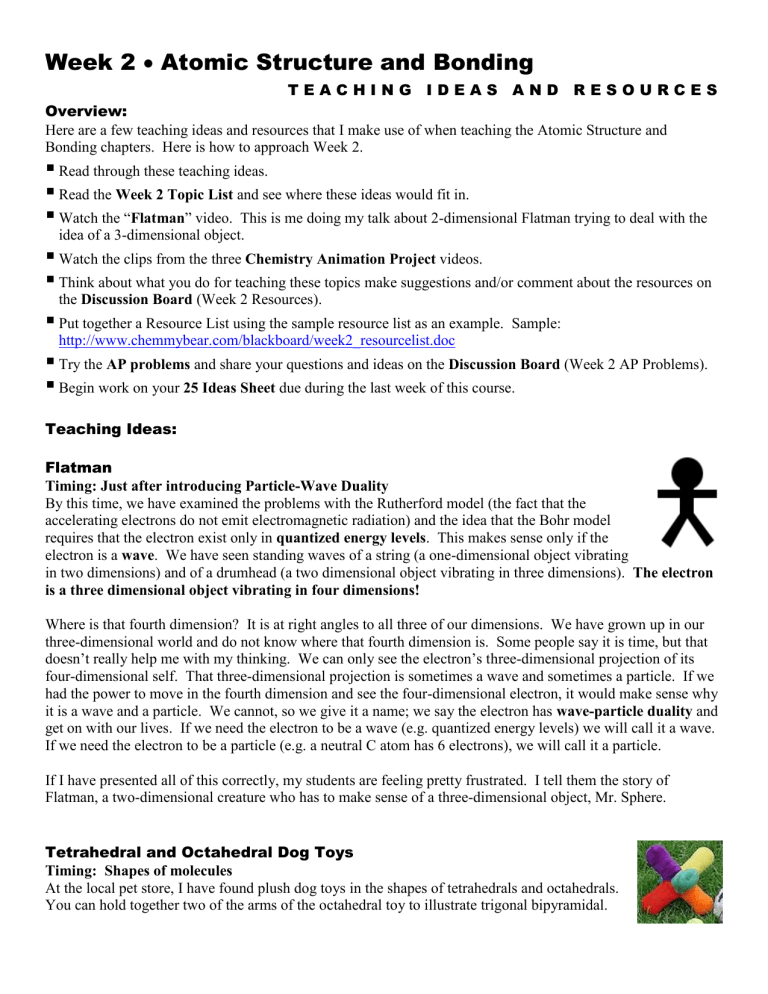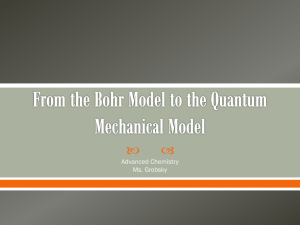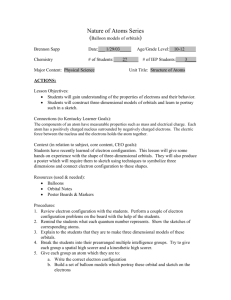Unit 5 • What Do Atoms Look Like

Week 2
Atomic Structure and Bonding
T E A C H I N G I D E A S A N D R E S O U R C E S
Overview:
Here are a few teaching ideas and resources that I make use of when teaching the Atomic Structure and
Bonding chapters. Here is how to approach Week 2.
Read through these teaching ideas.
Read the Week 2 Topic List and see where these ideas would fit in.
Watch the “ Flatman ” video. This is me doing my talk about 2-dimensional Flatman trying to deal with the idea of a 3-dimensional object.
Watch the clips from the three Chemistry Animation Project videos.
Think about what you do for teaching these topics make suggestions and/or comment about the resources on the Discussion Board (Week 2 Resources).
Put together a Resource List using the sample resource list as an example. Sample: http://www.chemmybear.com/blackboard/week2_resourcelist.doc
Try the AP problems and share your questions and ideas on the Discussion Board (Week 2 AP Problems).
Begin work on your 25 Ideas Sheet due during the last week of this course.
Teaching Ideas:
Flatman
Timing: Just after introducing Particle-Wave Duality
By this time, we have examined the problems with the Rutherford model (the fact that the accelerating electrons do not emit electromagnetic radiation) and the idea that the Bohr model requires that the electron exist only in quantized energy levels . This makes sense only if the electron is a wave . We have seen standing waves of a string (a one-dimensional object vibrating in two dimensions) and of a drumhead (a two dimensional object vibrating in three dimensions). The electron is a three dimensional object vibrating in four dimensions!
Where is that fourth dimension? It is at right angles to all three of our dimensions. We have grown up in our three-dimensional world and do not know where that fourth dimension is. Some people say it is time, but that doesn’t really help me with my thinking. We can only see the electron’s three-dimensional projection of its four-dimensional self. That three-dimensional projection is sometimes a wave and sometimes a particle. If we had the power to move in the fourth dimension and see the four-dimensional electron, it would make sense why it is a wave and a particle. We cannot, so we give it a name; we say the electron has wave-particle duality and get on with our lives. If we need the electron to be a wave (e.g. quantized energy levels) we will call it a wave.
If we need the electron to be a particle (e.g. a neutral C atom has 6 electrons), we will call it a particle.
If I have presented all of this correctly, my students are feeling pretty frustrated. I tell them the story of
Flatman, a two-dimensional creature who has to make sense of a three-dimensional object, Mr. Sphere.
Tetrahedral and Octahedral Dog Toys
Timing: Shapes of molecules
At the local pet store, I have found plush dog toys in the shapes of tetrahedrals and octahedrals.
You can hold together two of the arms of the octahedral toy to illustrate trigonal bipyramidal.
The Aufbau Hotel
Timing: When Introducing Electron Configurations
Floor Suite s
Penthouse p
Deluxe d
4
Fantasy f
3
2
1
The Aufbau Hotel (idea by Tom Wooster) is a strange hotel because Price Schedule for Rooms as you move up the floors, there are more and more rooms. On the first floor, there is only a suite. We symbolize it as 1s (1 st
-floor suite). On the second floor there is a 2 nd
-floor suite ( 2s ) and also
5s
5p
4d three penthouse-type rooms ( 2p ). The diagram above shows the layout of the hotel.
The price of these rooms, however, is a different matter. The 2 nd
floor suite costs more than the 1 st
-floor suite because even though the room itself is identical, it is higher in the hotel with less street noise and a better view. The same with the 3 rd
-floor suite compared to the 2 nd
-floor suite, etc. The penthouse-type rooms, however, are much nicer rooms and cost more than the suites even though they are on the same floor.
4s
3s
2s
4p
3p
2p
3d
1s
The important feature comes when you look at the price of the 3 rd -floor deluxe rooms. They are SO nice that they are in the same price range as the 4 th
-floor suites and 4 th
-floor penthouse-type rooms. Students ask why we don’t call them
4d… that is because they are located on the third floor.
This analogy helps students separate the ideas of energy (price) and location. For example, 3s, 3p, and 3d orbitals are all the same average distance from the nucleus even though they have different energies. Further, atoms fill their orbitals with electrons according to energy (e.g. 4s fills before 3d ) but atoms lose their electrons according to location
(e.g. 4s are lost before 3d ). I have found this analogy very, very useful.
Sound Tubes
Timing: Quantized Energy Levels
When the Bohr atoms requires that the electron only exist in quantized energy levels, students have a tough time with the concept of quantized because few things in our life are quantized. However, by spinning this tube at different speeds, you can play five different tones and five tones only. The tones are quantized. If you do it correctly, you can play “Taps”. You can only play those notes because they are caused by the standing waves of the sound waves within the tube. Only certain wavelengths will add and cancel to fill the tube (the open ends are antinodes).
Tetrahedral Bubbles
Timing: Sometime after we have talked about shapes
I put out some toothpicks and some cubes of potato (about 1 cm cubes) and ask pairs of students to make a tetrahedron . They invariably make a tetrahedral molecule, like CH
4
, using five potato cubes and four toothpicks. I give them time to make this mistake and then point out that
I do not want a tetrahedral molecule, I want a tetrahedron . If no one gets it, I give more hints (a four-sided figure, use six toothpicks and four potato cubes.) As soon as one team gets it, I have everyone look at it.
When everyone has a tetrahedron, I say use one more toothpick as a handle and dip the tetrahedron into one of the 1-Liter beakers of soapy water I have placed around the room (usually 3 or 4 beakers are enough).
The result is a very cool looking tetrahedral bubble. The soap solution is simply a little dishwashing soap (Dawn) in water… nothing special. I don’t care that the bubbles don’t last very long. I have students throw everything away because the potato cubes turn brown. This makes the
These guys use raisins.
I use potato cubes.
point that a tetrahedral molecule has atoms that point to the corners of a tetrahedron and it makes a good break from lecture.
Write and See Squares
Timing: The Photoelectric Effect
The photoelectric effect is an important experiment because its explanation involved the idea that light (thought of as waves) must be particles (photons). Students are surprised when they learn that
Einstein earned his Nobel prize for explaining the photoelectric effect, not E=mc
2
or his theory of relativity.
The photoelectric effect is usually demonstrated with a piece of zinc metal lit with a UV light. The light provide energy for electrons to leave the metal. If the demonstration is repeated with light of a longer wavelength (blue or violet) it does not work. Even if the blue light is very, very bright, it does not work. This shows that it does not matter how much total energy is applied, rather it is the energy per particle of light that makes a difference.
Analogy: PBS often has pledge drives with people on telephones in the background of the celebrities talking about donating to PBS. When someone donates $100, the phone person rings a cowbell. Imagine two volunteers manning the phones. One gets many donations ($90, $75, $99, $50, etc.) but never rings the cowbell. Another volunteer gets maybe one phone donation for $100 and gets to ring the cowbell. The first volunteer collects a large amount of money, but never enough per donation to ring the cowbell. UV light is the same. Even a tiny UV light will excite a few electrons because there is enough energy per particle of light .
The large blue light (a laser, perhaps) can deliver much more total energy, but not enough per particle of light to excite the electrons.
Educational Innovations (see the link on chemmybear.com) sells these little foam boards covered with phosphorescent film called “Write & See Squares”. If you write on them with a blue LED flashlight, the writing shows up. If you use a red LED flashlight, nothing happens. Even if you use a red laser (I even have a green laser) nothing happens. The light energy has to be at least blue to excite the electrons.
Why do we care: When we speak of electrons (particles) having quantized energy levels , the electrons must be waves . We know, however, that electrons are particles (we know their mass, their momentum, and we count them). This dual nature of matter is called wave-particle duality.
The Bond Type Triangle
Timing: When talking about bond types
I used to talk only about the difference in electronegativity (
EN) for bond type. Ionic bonds (
EN > 1.7), Nonpolar Covalent bonds
(
EN < 0.5) and Polar Covalent bonds somewhere in between.
Some student would ask about two metals… with
EN < 0.5.
This bond type triangle helped me. The vertical axis is difference in electronegativity. The horizontal axis is average electronegativity.
The little dark triangle at the bottom is semi-conductors, I believe.
Videos:
TV Ontario (Structure of the Atom)
This is an old video series that I am not even sure is still available. There is a TV Ontario web site, but I couldn’t get the online educational catalog to work. It consists of six 10-minute episodes with very old computer graphics, but the video does a great job of building up the Atomic Theory. It begins with Democritus, moves through John Dalton, J.J. Thomson, Ernest Rutherford, Bohr, and Einstein. In between it includes many others (Faraday, Coulomb, Proust, Lavoisier, etc.). The emphasis is on the experimental evidence that led to the modern atomic theory. Whenever possible, I try to replicate the experiments in class (cathode ray tubes and magnets, electrolysis, etc.) URL: http://www.tvontario.org/sales/
Caltech – Chemistry Animation Project
[Atomic Orbitals (10 minutes) / VSEPR (10 minutes) / Periodic Trends (20 minutes)]
These videos are sold in the Caltech bookstore for their underclassmen to purchase and watch. The graphics are very good as is the presentation. You can order these online directly from the Caltech bookstore. I have also seen these video recently in the Flinn Scientific catalog.
Atomic Orbitals shows the shapes of the s, p, d, and even f orbitals. They go into detail about the nodal surfaces, but I tell my students that we can imagine that 3p, 4p, 5p orbitals all essentially look/act like 2p orbitals, etc. I like this video because it shows the shapes of f orbitals and relates the orbitals to the position of elements on the periodic table.
VSEPR is a great visualization of the valence shell electron pair repulsion model. I especially like this video because it introduces the very useful idea of steric number (# of bonded atoms + # of lone pairs). Before this, I used to talk about the number of “things” bonded to the central atom. Students learn to apply steric number
(SN) very quickly. This is useful for hybridization (SN = 2
sp, SN = 3
sp
2
, etc.) as well as shapes. The other feature I like is that the video morphs from Lewis symbols to bonds to 3-dimensional structures which models for students the link between those three ideas. [Note: this video is currently not available anywhere.]
Periodic Trends is a very good (but kind of tedious) video. There is a little simulated animal violence which seems kind of out of place, but keeps the students amused. The strength of the video is that it gets down to the explanation for the trends in terms of attraction and repulsions of electrons and protons. There are always questions on the AP exam where students need to explain these ideas. Students often state the trend instead of giving a real explanation. I also really like the idea that they state that Neon, a noble gas, has a high ionization energy because of the large number of protons in its nucleus and a low electron affinity because to gain an electron, the electron would have to occupy the high energy 3s orbital… so Neon is unreactive because it
neither gains or loses electrons… not because of some mysterious unexplainable stability of the completed shell.
There are other titles. I have the Molecular Orbitals and Crystals videos. Molecular Orbital theory is not part of the AP curriculum, but if you teach it, you might want to get a copy. The Crystals video talks a lot about Miller indices which I don’t know anything about. I haven’t seen the videos dealing with the organic chemistry topics. http://www.bookstore.caltech.edu/CALTECH/shop_product_list.asp?catalog_group_id=MjM&catalog_group_ name=Q2hlbWlzdHJ5IEFuaW1hdGlvbiBQcm9qZWN0&catalog_id=145&catalog_name=Q2hlbWlzdHJ5IEFu aW1hdGlvbiBQcm9qZWN0
Atom Bond—The Atom with the Golden Electron
(28 minutes)
This is an award-winning Canadian film that is a spoof of James Bond movies. It is a lot of spheres (elements) running around talking together, but I love it as a culmination of bonding. There are a lot of puns that students will only get if they understand about bonds, electrochemistry, intermolecular forces, aqua regia, etc. It does a good job of illustrating covalent bonds, London forces, network solids, dipole-dipole interactions, etc. The ending is very anti-climactic, but I still think this is well worth the money. It costs $99 from Discovery. http://store.discoveryeducation.com/product/show/51174
Online Resources:
Standing Wave Graphic
Timing: Introducing Standing Waves
We need to understand the idea of Standing Waves so we can later say that an electron is a four-dimensional standing wave. The simplest standing wave is a string. I use a long, white telephone cord to demonstrate standing waves. One wave disturbance travels one direction on the string and bounces back. If the frequency is just right, the waves going in the two directions constantly cancel each other out at certain points (nodes) and constantly add together at other points
(antinodes). This is illustrated very nicely in a simple graphic on chemmybear.com. I ask students to simply stare at it for awhile to understand what I am talking about. http://www.chemmybear.com/standing.html
Chemistry—The Science in Context
One example: The Rutherford Experiment
This animation recreates the Rutherford Gold Foil Experiment.
This particular tutorial is not very interactive and does not contain any practice problems, but it does show the visual way these tutorials are put together. As a collection of tutorials, I find these very useful… a great resource. The textbook itself is a fine resource for applications of chemical ideas.
Link to the Tutorial
URL: http://www.wwnorton.com/college/chemistry/gilbert2/tutorials/interface.asp?chapter=chapter_02&folder= rutherford_experiment







